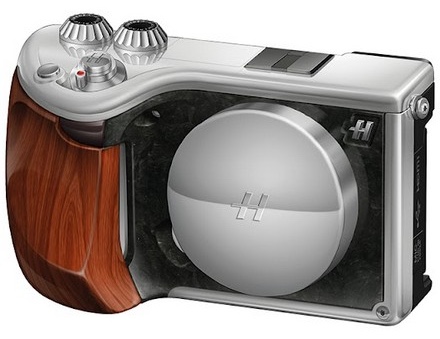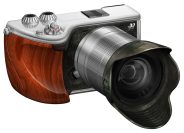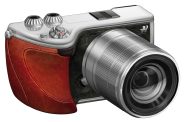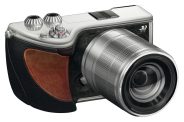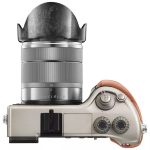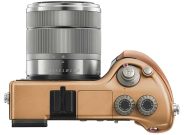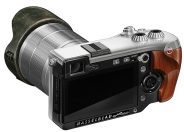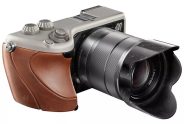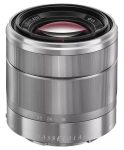Hasselblad Lunar
APS-C AF digital mirrorless camera • Discontinued
Specification
| Format: | |
| APS-C | |
Imaging sensor: | 23.5 × 15.6mm CMOS sensor |
Resolution: | 6000 × 4000 - 24 MP |
Crop factor: | 1.53x |
Sensor-shift image stabilization: | - |
| Sony E [18mm] | |
| Shutter: | |
Type: | Focal-plane |
Model: | Electronically controlled |
Speeds: | 30 - 1/4000 + B |
| Exposure: | |
Exposure metering: | Through-the-lens (TTL), open-aperture |
Exposure modes: | Programmed Auto |
| Aperture-priority Auto | |
| Shutter-priority Auto | |
| Manual | |
| Physical characteristics: | |
Weight: | 570g |
Dimensions: | 142x82x70mm |
Manufacturer description #1
18/09/2012 - Hasselblad, manufacturer of the world’s most advanced medium format camera system, has announced a revolutionary plan to market a state-of-the-art, Italian-designed ‘ultimate luxury’ mirrorless, interchangeable lens camera early next year.
Luca Alessandrini Hasselblad’s New Business Development Manager said: “The Lunar is a celebration of the passion that the company’s founder Victor Hasselblad had for photography. We’ve developed this model in the traditional way, using handmade wooden prototypes to ensure superior ergonomics and functionality. This is a camera for both serious photographers and enthusiasts who aspire to shooting with a Hasselblad.”
He added: “Lunar, which can be used in fully automatic or fully manual mode, has been designed to be easy to use and versatile but with all the advanced technology employed in top DSLRs. For the first time the market now has a camera embracing traditional Hasselblad state-of-the-art image capture combined with stunning Italian design features.
And for the first time ever we are using carbon fiber, titanium, wood, leather and precious metals – including gold. The camera grip itself offers unparalleled ergonomics and has been developed to embrace both compact E-mount and the larger professional A-mount lenses.”
The Lunar, which is set for launch in the first quarter of 2013, will be priced circa 5000 Euros and will be available in a choice of standard models plus a variety of exclusive hand grips and precious materials on special order.
Hasselblad will showcase a unique ‘Lunar experience’ at photokina. Visitors to the stand (Hall 2.1 Stand A-021/B-020) will see a ‘snapshot’ of latest work-in-progress designs and wood- en models, purpose-built to demonstrate the company’s pioneering ‘ideal luxury’ camera vision.
Dr. Larry Hansen, Hasselblad Chairman and CEO said: “It has always been my ambition to enable all fans of the iconic Hasselblad brand to have an opportunity to own one of our cameras. The company mission is to develop exceptional products at the very top end of the market segments in which we operate. In 1962 astronaut Walter Schirra took the first Hasselblad camera into space. Walter had painted the 500C’s metal surface black to minimise reflections. Now, in celebration fifty years later, we have developed Lunar – an aesthetically and ergonomically beautiful piece of camera art, complete with colour options and an evocative vintage look and feel, for photography lovers down here on planet Earth.”
Key Lunar features will include:
- DSLR-like performance thanks to the highest technology APS-C 24.3 MP sensor with 25AF points focusing matched to an Ultra fast Processor with real time image process ing and accurate RAW to JPEG translation.
- Accurate composition for both still and video in any light conditions thanks to the Ultra-bright 3” high definition display and revolutionary OLED viewfinder that guarantees superior contrast and ultra fast response.
- One-touch instant full HD video recording to shoot in Auto or fully manual mode. Focus and exposition control plus the connection for an external microphone and the option to use larger A-mount lenses for professional video creation.
- Instant shutter response (0.02 second release time lag) ten frames per second and an extremely Wide ISO 100 -16000 range.
- The camera software includes an exceptionally comprehensive set of creative styles, picture effects, scene selections and the smart ”intelligent face registration” making the shooting experience even more fun.
- Auto HD, DRO and Anti-motion blur mode.
- An Innovative TriNavi system for DSLR-like tuning, two flash options and Anti dust system complete the Lunar state-of-the-art package.
Added Dr. Hansen: “This new model is the result of meticulous engineering research, culminating in the creation of an unprecedented camera which underpins the Hasselblad mission to pioneer and produce supreme quality across all our products.”
Manufacturer description #2
19/09/2012 - Hasselblad plans groundbreaking Lunar launch
The world’s imaging press gathered at the Hasselblad photokina press conference yesterday to hear breaking news about the company’s plans to launch into new market segments.
Hasselblad has announced a pioneering plan to launch ‘Lunar’, a state-of-the-art, Italian-designed ‘ultimate luxury’ mirrorless, interchangeable lens camera early next year.
Journalists watched as the company showcased its ‘Lunar experience’ using latest ‘work-in-progress’ designs and wooden models, purpose-built to demonstrate Hasselblad’s ‘ideal luxury camera’ vision. The camera will be available in different combinations of precious metals including titanium and carbon fibre – and also leather and wood.
Hasselblad’s advance into new market segments follows a ‘new-dawn’ technology collaboration agreement with Sony. The two iconic organisations will work together in ‘a merger of science and engineering talent’ aimed at achieving new technical and engineering breakthroughs.
Dr. Larry Hansen, Hasselblad CEO and Chairman said: “It has always been my ambition to enable all fans of the iconic Hasselblad brand to have an opportunity to own one of our cameras.”
Hasselblad also announced the launch of its new flagship H5D medium format camera series, complete with a new 24 mm lens and macro converter – and showcased camera prototypes on the booth. The ‘next generation’ H5D features a modernized design and a completely new electronic engine, to pave the way for ultimate quality imaging, for print ready JPEG files, and for a smooth and intuitive user interface. The H5D will ship in December this year.
Manufacturer description #3
A great challenge: reinterpreting a unique style.
Hasselblad has entrusted to Lunar the difficult but fascinating task of reinterpreting the appeal of a myth: the legendary 500C of 1957, the first camera to go into space. A camera that, starting from that moment, has become an object of desire for every photographer around the world. Thanks to this camera some of the most evocative and iconic images of our time have been captured. Today Lunar revives the timeless charm of the 500 through the iconic chrome-plated frame, made smooth and sinuous by the total absence of edges. Even the contrast in colour between the camera body, the lens, and the protruding control buttons, is faithfully reproduced to offer an evocative vintage look with a decisively elegant appeal.
The quest for perfection has been our brand’s mark of distinction since its origin. Our goal is to always attain the best product, even when this means going back to past techniques. A large number of wooden prototypes were crafted in order to create Lunar. Compared to the usual product design based on 3D software models, the use of prototypes ensures a more harmonious and ergonomic development of shapes. The outcome can now be seen by everyone.
A passion for uniqueness.
Talent, patience and elegance with an artisan’s touch. Leather and wood, these carefully selected raw materials, are turned into timeless stylish details recalling the know-how of authentic artisan masters. Traditional skills, the development of special techniques, a passion for perfection: everything comes together to create objects of exceptional quality, unique because they are perfected one by one, different as only the hand of an artist can make them.
Lunar. Vintage and high-tech, Italian design and Swedish tradition for a camera featuring a unique and unmistakable style.
Talent, patience and elegance with an artisan’s touch. Leather and wood, these carefully selected raw materials, are turned into timeless stylish details recalling the know-how of authentic artisan masters. Traditional skills, the development of special techniques, a passion for perfection: everything comes together to create objects of exceptional quality, unique because they are perfected one by one, different as only the hand of an artist can make them.
The latest carbon fiber technology for maximum strength and durability.
Aerospace industry has always contributed to raise the bar of technology and engineering. One of the results of this quest is the relatively new Compression Moulding Carbon Fiber technique. This process combines the strength and lightness of carbon fibers with the precision and design freedom of injection moulding parts. Lunar is the world’s first camera in using this exceptional material.
Machined high-grade aluminum for a top quality camera body.
The latest marketing trend in the camera industry is to manufacture casted magnesium bodies for the sake of light weight. The old-school aluminum is yet much more resistant to corrosion, more durable and much tougher than magnesium, above all when it is machined from a solid block of top quality alloy. Like in our Lunar.
The strongest and most technical coating treatment.
PVD (Physical Vapor Deposition) is the cutting edge technology in the field of surface treatments. Developed as a hardening treatment for high speed cutting tools, it has recently evolved into top class aesthetical finishing. It combines outstanding hardness, second only to diamond, with beautiful bright colors.
Titanium Controls for a lifetime.
All main controls are made of uncoated natural titanium, typically used to produce strong and lightweight aerospace components. The two most useful properties of titanium are corrosion resistance and the highest strength-to-weight ratio of any metal. Controls made of this valuable material are guaranteed to last virtually forever without a sign of wear or oxidation.
Carbon Fiber. High-Tech Style.
The carbon grip combines a decisively high-tech look with the exceptional characteristics of resistance and lightness found in this extraordinary material. Available in three different shades of colour (silver, titanium and black), this is the right choice for those who love minimal style and exclusive details.
Natural wood. The warmth of tradition.
Beech, olive, pear and mahogany: all with a waxless matt finish to optimize the grip. The best Italian wood is selected to create grips that come across like paintings of artistic perfection. Attention focuses on the most beautiful wood grain, on the original shades of colour, on the compactness and fragrance of the finest wood. Each camera is a little masterpiece that makes it absolutely unique.
Italian leather. All about class.
The very best Italian leather, including the one used for the most exclusive car steering wheels and interiors for the leading state-of-the-art manufacturers. The possibility to choose from a wide variety of styles and colours. Each grip recounts a tale of class and elegance that your fingers can read by covering the countless paths scored by the texture of these extraordinary materials. The charm of times gone by is revived in a technologically perfect camera.
A formula for perfection.
Careful and meticulous engineering research has led to the creation of an unprecedented camera. The perfect calibration of its body makes it possible for Lunar to support both compact and professional DSLR’s lenses while always ensuring excellent balance. The relationship between user and camera is completely personalised thanks to the possibility to choose the favourite material of the handgrip. Anyone who has the pleasure of laying their hands on a Lunar has access to a sensory experience made of comfort, warmth and perfect grip. An almost magnetic effect that causes irresistible attraction.
A perfect union between camera and man has been a complished.
From the editor
Essentially a restyled Sony NEX-7. The camera body was available in versions with black leather, brown Tuscan leather, carbon fibre, mahogany Italian wood or olive wood grip, and accompanied by a silver Hasselblad E 3.5-5.6/18-55 OSS lens, which was identical to the Sony-branded version. Instead of a 18-55mm standard zoom, the camera could be purchased with Hasselblad E 16mm wide-angle or 18-200mm superzoom lenses, which were also identical to the original Sony-branded lenses.
Hasselblad Lunar special editions (2)
- Hasselblad Lunar Limited Edition (200 units) - January 2014
- Hasselblad Lunar Limited Edition (400 units) - July 2014
Similar cameras (23)
| Model | Shutter | Metering | Modes | Year |
|---|---|---|---|---|
| Sony a3000 | E, 1/4000 | TTL · OA | PASM | 2013 ● |
| Sony a3500 | E, 1/4000 | TTL · OA | PASM | 2014 ● |
| Sony a5000 | E, 1/4000 | TTL · OA | PASM | 2014 ● |
| Sony a5100 | E, 1/4000 | TTL · OA | PASM | 2014 ● |
| Sony a6000 | E, 1/4000 | TTL · OA | PASM | 2014 ● |
| Sony a6100 | E, 1/4000 | TTL · OA | PASM | 2019 ● |
| Sony a6300 | E, 1/4000 | TTL · OA | PASM | 2016 ● |
| Sony a6400 | E, 1/4000 | TTL · OA | PASM | 2019 ● |
| Sony a6500 | E, 1/4000 | TTL · OA | PASM | 2016 ● |
| Sony a6600 | E, 1/4000 | TTL · OA | PASM | 2019 ● |
| Sony a6700 | E, 1/8000 | TTL · OA | PASM | 2023 ● |
| Sony NEX-3 | E, 1/4000 | TTL · OA | PASM | 2010 ● |
| Sony NEX-3N | E, 1/4000 | TTL · OA | PASM | 2013 ● |
| Sony NEX-5 | E, 1/4000 | TTL · OA | PASM | 2010 ● |
| Sony NEX-5N | E, 1/4000 | TTL · OA | PASM | 2011 ● |
| Sony NEX-5R | E, 1/4000 | TTL · OA | PASM | 2012 ● |
| Sony NEX-5T | E, 1/4000 | TTL · OA | PASM | 2013 ● |
| Sony NEX-6 | E, 1/4000 | TTL · OA | PASM | 2012 ● |
| Sony NEX-7 | E, 1/4000 | TTL · OA | PASM | 2011 ● |
| Sony NEX-C3 | E, 1/4000 | TTL · OA | PASM | 2011 ● |
| Sony NEX-F3 | E, 1/4000 | TTL · OA | PASM | 2012 ● |
| Sony ZV-E10 | E, 1/4000 | TTL · OA | PASM | 2021 ● |
| Sony ZV-E10 II | E, 1/8000 | TTL · OA | PASM | 2024 ● |
